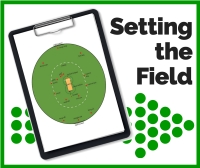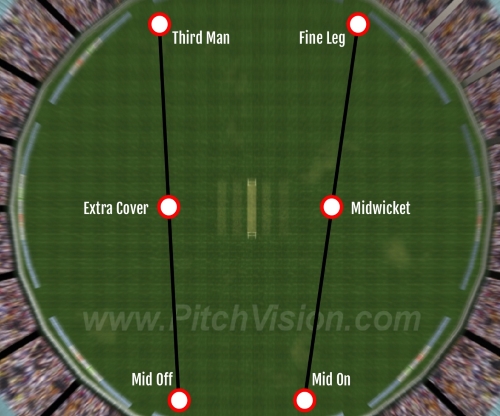Setting the Field: Theory and Practice
 From orthodox to funky; being a better captain and bowler means mastering the art of setting the field in your cricket matches.
From orthodox to funky; being a better captain and bowler means mastering the art of setting the field in your cricket matches.
Chances are you know fields that suit certain bowlers and match situations. There is much more to it that that though. There are some underlying principles of field setting that allow you to become more flexible while basing everything in solid logic.
The result of understanding the core of field setting is that you can have the right players in the right places at the right time. And that's going to get you more wickets.
1. Core cricket fielding positions
There are two reasons to set a cricket field: To take wickets and to stop runs being scored.
To do either of these things, most bowlers bowl with the aim of hitting "the top of off". This is to say; straight at the stumps with the ideal ball striking the off stump. In reply, most batsmen will try and hit the ball straight with drives. This is hitting through the famous 'V' using cover, straight and on drives.
In this situation the fielders need to be in position to stop these shots (and edges). In other words, the V can be inverted to create a line of defence on each side of the wicket. So, this is the basic framework, or core positions from which to build:

- Mid on and mid off stop the straight drives.
- Third man and fine leg are there to stop the edged ball.
- Extra cover and Midwicket stop the wider drives.
One important factor to note is that the fielders always form a straight line from one end of the pitch to another. If this does not happen (someone too close or deep) then the gap the batsman can see is bigger and more runs can be scored. So set fielders in the right place and don't let them wander.
If the bowler bowls perfectly and the batsman responds with a straight bat, these core six fielders are enough for a bowler to defend effectively. This leaves you three spare fielders that you can set anywhere you like. See below.
Of course, this theory ignores the many variations that makes cricket so interesting and setting the field so challenging. It's your starting point.
2. Refining the field
Once you understand the core positions, you can start to work out the variations. With every variation, different positions are brought in or taken out of play. These are:
- Match situation. Are you attacking or defending?
- Type of bowling. Spinners, medium pace or fast bowlers?
- Pitch conditions.
- Accuracy of bowling.
- Swing and seam movement.
- Batter's style and limitations. All batsmen favour certain shots and ignore others.
The simple way to look at it is to put the fielders where you think the ball is most likely to go.
The basic principles still apply, and each change must be considered carefully with justification and not just chasing the ball by putting fielders where the batter hits it.
For example, perhaps you are all out attacking with a fast bowler on a fast pitch with plenty of bounce. Your three spare would all be attacking (say, two slips and a gulley). Your aim is to get wickets you could forget about fine leg and third man and move them to close catching, an extra slip and a leg slip or short leg.
If the batter plays with an open face you might consider cutting off his square shots with 2 gulleys or a square third man, especially if your bowler bowls outswing as a stock ball.
Each player is different. Variations in technique lead to the ball going in different places. So, work players out from the moment you first see them. Remember the basics still apply: You are trying to cut off a scoring shot or be there when a mistake is made.
These two aims often work in harmony. A batsman who has had their favourite couple of shots shut off will make mistakes. This combination will lead to wickets. This is where sometimes defence can be a form of attack. The modern term in limited over cricket is 'putting the squeeze on'. This is where a fielding side aim to block off every run with tight fielding. Climbing run rates always lead to errors As captain your aim is to work out how to do this quickly.
On the other side, if you are trying to take wickets, it's better to attack a little too much with your field than play too safe. This is not just for the sake of taking wickets, if you trust your bowlers by setting more attacking fields you are building their confidence.
Each situation demands your full attention because the variations are never-ending. That is not to say you set a strange field for the sake of it. Your ideas always must have solid grounding in the basics. Be aware that you have a framework to work from and flexibility to be creative depending on the situation.
3. Get funky fields to work
The final principle of setting a field is the ability to bluff. There will often be times where setting the best field may not be the best way of reaching your aims and this is where a poker face and a funky field comes in handy.
Bluffing does not mean you should forget the first two principles, but once you have laid your plans you can double cross with a clever field placing that looks sinister.A classic example is an off spinner who does not turn the ball much setting two short legs and a wide slip. This could make the batter think it is turning and the slip getting lots of catches. The short legs are just the bluff.
Perhaps you have a weak fielder who you need to hide. Instead of just plonking him at mid on or fine leg, you could put him at silly point to an off spinner to crowd the batter. He may never catch a cold, but nothing will come to him anyway and at least he is putting the batsman off.
Again, there are many bluff strategies for many situations. However the same rules apply: Don't forget the basics and keep thinking. Also, never try your bluffs for too long. Most are rumbled quickly, especially if they get a wicket.
In all honesty, an orthodox field will mostly do the job you need. However if you understand why you are putting a player somewhere you are bound to be more confident. Your plan may not come off but at least you did it because of a plan and not because you didn't know what else to do.
This is the true art of placing your field; knowing in your own mind why you are doing things.
- Login to post comments


Comments
[...] The essential difference between the two forms is that you don’t need to bowl the opposition out to win. This means you are looking to defend in the field far more quickly, ideally using the basic field placing structure to cut off as many runs as possible in the V. [...]
[...] tactics. Ask each other why the captain has moved the field or brought on a certain bowler. Is it bluff or genius? Come up with ways to counteract his [...]
[...] from you. Defense or attack? Aggression or control? Work out what the bast basic line, length and field setting is for your particular role and stick to it. It’s handy to have a ‘plan B’ too, but only if [...]
Great stuff, very helpful
jkniugyufuy
how to grip Bat . I cant hit six. and my bat dont finish short at shoulder.
Acha tha